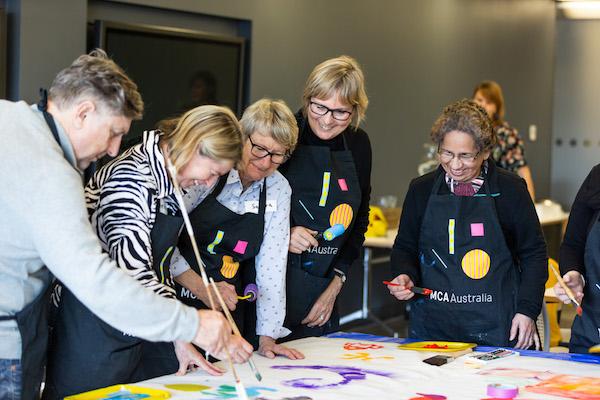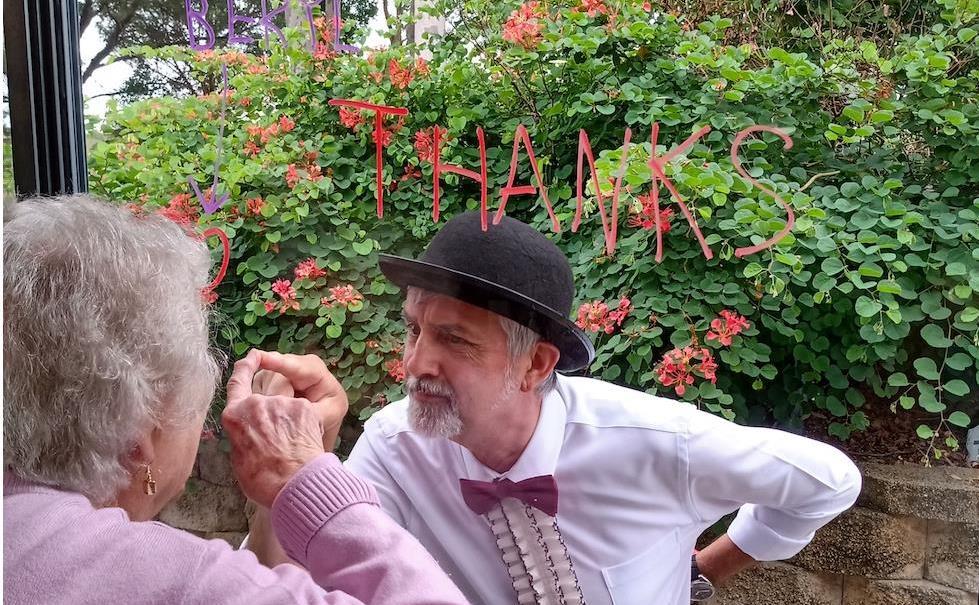Picture this scene: a man appears at the window of a residential care facility in the Hunter Valley and is shot at with foam bullets by residents on the other side of the glass armed with Nerf guns. A sense of frivolity fills the room.
When COVID-19 restrictions were first put in place, Maurie Voisey-Barlin immediately thought of his elderly dementia clients in the Hunter Valley.
Working as a creative therapeutic engagement specialist, a job he describes as similar to a ‘court jester’, Voisey-Barlin would previously engage with his clients in a cheeky manner to provoke a response. With the pandemic keeping him from physically entering residents’ rooms, Voisey-Barlin was keen to continue his program from the outside, and thus ‘Window Therapy’ was developed.
‘With the potential dislocation from the physical and personal world that these necessary visitor precautions may bring, our elders living in care need person-to-person connection and interaction more than ever,’ Voisey-Barlin told ArtsHub.
His window therapy program first began at Whiddon Largs Residential Aged Care, one of Voisey-Barlin’s partner clients, and is now being delivered at Whiddon Belmont, Merton Living and will be trialled next week at Amaroo Aged Care, Charlestown.
Techniques used to engage residents include writing messages on windows with whiteboard markers, playing games such as noughts and crosses and charades, and using role play to make social distancing restrictions fun, with residents instructed to keep Voisey-Barlin out of the facility and him ‘pretending’ to try and enter at all costs.
With everyone adapting to lifestyle changes during this time, contemporary life can be daunting for those who rely on routine, particularly for people with dementia.
Earlier this year the Museum of Contemporary Art (MCA) introduced its Artful: Art and Dementia toolkit, an innovative online resource offering artist-led, creative activities based on the Museum’s onsite art and dementia program.
MCA’s Audience Engagement Manager, Yaël Filipovic, said art is important for the elderly during COVID-19. ‘Any change in someone’s routine can be hard, especially if they struggle to remember why this change has happened. All this adds up to an especially difficult time facing this community and offering creative engagement supports meaningful and fun ways to engage an individual living with dementia,’ Filipovic explained.
‘Finding ways to smile and play through creative activities is more important than ever for most of us at the moment and contemporary art can offer the opportunity to step outside of your day-to-day life and connect with something beautiful.’
FACILITATING A HEALTHY ARTS PRACTICE
MCA’s toolkit offers ten art-making activities, including painting, printmaking and drawing, and can be used in a number of settings, including at home, in a healthcare setting, or in a gallery. Benefits provided include stimulation, encouraging conversation and memory recall, and the use of motor skills.
The toolkit has been designed to be facilitated by a care partner at home, in collaboration with a loved one living with dementia; or in the context of an aged care setting by staff with a small group of clients.
Voisey-Barlin said the importance of facilitators can’t be underestimated, especially considering their involvement in helping to make window therapy a workable practice alongside more established activities and programs.
‘The success of the engagement is influenced by the person you are working with on the other side of the widow, namely the Activities/Lifestyle Officer who encourages the elders to join in,’ he said. ‘They are on the other side of the window with the elders and help the interactions from inside, making it fun, perhaps provoking some mischief and helping to focus the elders in adding to the cheeky playful responses.’

Participants of the MCA’s onsite Art and Dementia program. Image: Jacquie Manning.
Whether he’s presenting the residents with a photo of his grandson, calling them on the phone and watching their interaction through the window, or drawing a caricature of them and holding it up for them to see, the joy felt is palpable.
‘The elders will flash you a look of deep appreciation as they sense you are trying to create some playful, connected and meaningful moments,’ he said. ‘It is important to moderate the approach so that it’s not all-high energy slapstick. You want to enable all the emotions to be felt. This is the challenge.’
His hope is that window therapy will be adopted by engagement specialists, performers, artists, entertainers and creatives who have been working in the arts health sector.
Voisey-Barlin said creative engagement and art for the elderly is particularly important now, especially for those who aren’t familiar with social media or video conferencing calls.
‘I think during this period the arts can really deliver something really powerful because the technology that people are trying to use is great, but this isn’t the generation that has adopted that technology.
‘The elderly need interaction, connection, and a bit of joy from outside,’ he concluded.
Visit LinkedIn to learn more about Window Therapy.
The MCA’s Art and Dementia toolkit can be purchased online through MCA and will be made accessible by The Jibb Foundation for those who can’t afford it, in recognition of its content during this difficult time.

